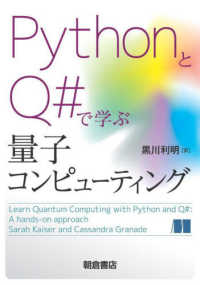- ホーム
- > 洋書
- > ドイツ書
- > Humanities, Arts & Music
- > Linguistics
- > german linguistics
Description
(Text)
Um 1900 war das medizinische Phänomen der Neurasthenie zu einem allgemeinen Störungsbild angewachsen, an dem sich das Unbehagen an der Moderne manifestierte. Die Neurasthenie war immer mehr als das psychische Leiden einzelner - sie war auch der Preis, den Gesellschaft für den Fortschritt zu zahlen hatte. Auch Thomas Mann war vom Nervendiskurs seiner Zeit wie auch vom Wissen um die Neurasthenie beeinflusst. Vor allem im frühen Werk, so in Buddenbrooks und Tonio Kröger, versammeln sich diese Themen wie in einem Brennglas: Zwischen Degeneration und Psychologie des Selbst ist die Neurasthenie zum Symptom einer Krise des bürgerlichen Subjekts geworden; so kann z.B. aus heutiger Sicht die Symptomatik Thomas Buddenbrooks als erste Fallvignette in der Geschichte des Burnouts gelesen werden. In diesem Band geht es aber nicht darum, die zur Schablone gewordene Deutung der Neurasthenie als Zeitkrankheit um 1900 auf die Gegenwart zu legen. Vielmehr sollen die Diskurse um Nervenkrankheit und künstlerisches Potential als zeitgebundene Debatten befragt und nach den Bedingungen des Schreibens im Spiegel der Neurasthenie gefragt werden. Die Wiederbesichtigung eines berühmten Topos - Krankheit und Kunst bei Thomas Mann - will damit einen neuen Blick auf ein altes Thema werfen.By 1900, the medical phenomenon of neurasthenia had grown into an image of general disorder manifesting the malaise of modernity. Neurasthenia was always more than the psychological suffering of individuals - it was also the price society had to pay for progress. Thomas Mann, too, was influenced by his contemporaries' obsession with time. Especially in his early works, such as Buddenbrooks and Tonio Kröger, these subjects come together as if focussed in a burning glass: between degeneration and the psychology of the self, neurasthenia has become a symptom of a crisis of the bourgeois subject; from today's perspective, for example, the symptomatology of Thomas Buddenbrooks can be read as the first casevignette in the history of burnout. In this volume, however, the aim is not to apply the interpretation of neurasthenia as a contemporary illness around 1900 to the present, which application has by now turned into a simple template. Rather, it aims to interrogate the discourses surrounding neurasthenia and artistic potential as time-bound debates and to ask about the conditions of writing in the mirror of neurasthenia. This revisiting of a famous topos - illness and art in Thomas Mann - thus aims to take a new look at an old topic.







